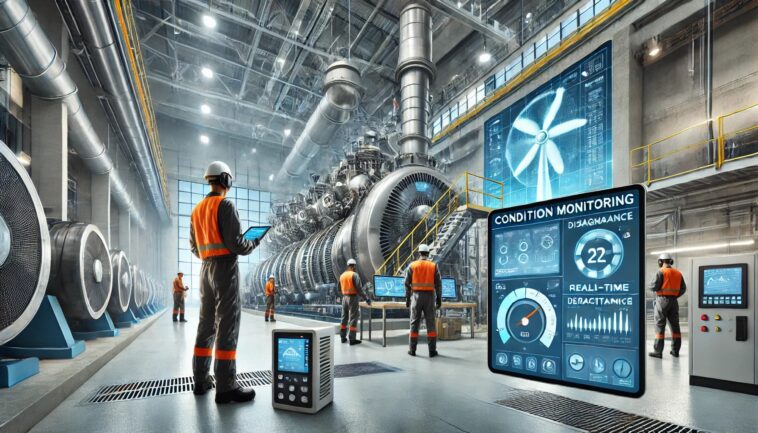In an increasingly competitive and technology-driven world, Condition Monitoring has emerged as a vital practice to ensure the efficiency, safety, and longevity of equipment and processes. But what is it, and why is it so critical to the success of modern businesses?
Condition monitoring (CM) refers to the process of continuously or periodically checking the health of machinery or systems to identify potential issues before they become critical failures. By using advanced technologies and tools, it allows businesses to maximize performance, reduce downtime, and optimize maintenance schedules.
This blog explores the ins and outs of condition monitoring, its techniques, benefits, and how it contributes to a sustainable business model.
Understanding Condition Monitoring
Condition monitoring combines predictive analytics, advanced sensors, and data interpretation to maintain optimal machinery performance. Its primary goal is to detect anomalies or signs of deterioration at an early stage, reducing the risk of unexpected failures.
Key Aspects of Condition Monitoring:
- Data Collection: Gathering real-time data from sensors embedded in equipment.
- Analysis: Interpreting collected data to identify patterns or deviations.
- Action: Prompting necessary maintenance or repairs based on analysis.
Condition monitoring is the backbone of predictive maintenance, allowing businesses to shift from reactive maintenance to a proactive approach.
How Does Condition Monitoring Work?
Condition monitoring works by evaluating specific parameters that reflect the health of equipment. This is achieved through a combination of hardware sensors and software analytics.
Common Parameters Monitored:
- Vibration: Excessive vibrations can signal misalignments, imbalance, or bearing wear.
- Temperature: Abnormal temperatures indicate overheating or insufficient cooling.
- Noise: Changes in noise levels can point to component damage.
- Lubrication: Monitoring oil levels and quality ensures smooth operations.
- Electrical Metrics: Voltage or current irregularities can indicate motor issues.
By using IoT-enabled devices, artificial intelligence (AI), and machine learning (ML), condition monitoring systems analyze this data in real time, predicting failures with remarkable accuracy.
Techniques in Condition Monitoring
There are various condition monitoring techniques, each tailored to specific machinery and operational environments.
1. Vibration Analysis
- Tracks vibrations to detect imbalances, misalignments, or component degradation.
- Widely used for rotating equipment like motors, pumps, and turbines.
2. Thermography
- Uses infrared imaging to identify temperature anomalies.
- Ideal for electrical systems, furnaces, and pipelines.
3. Ultrasound Monitoring
- Detects high-frequency sound waves associated with mechanical wear or leaks.
- Useful for valves, steam traps, and fluid systems.
4. Oil Analysis
- Examines lubrication fluid for contamination, wear particles, and chemical changes.
- Applicable for engines, gearboxes, and hydraulic systems.
5. Electrical Monitoring
- Evaluates voltage, current, and power quality to identify electrical issues.
- Focused on motors, generators, and transformers.
Benefits of Condition Monitoring
Condition monitoring is more than just a maintenance strategy—it’s a cornerstone of operational excellence.
1. Minimized Downtime
- Proactively addressing potential issues prevents unplanned outages.
- Increases equipment availability and reliability.
2. Cost Efficiency
- Reduces emergency repair costs and extends the lifespan of machinery.
- Lowers overall maintenance expenses by avoiding unnecessary interventions.
3. Enhanced Safety
- Early detection of faults reduces the risk of catastrophic failures, protecting workers and assets.
- Ensures compliance with safety regulations.
4. Optimized Performance
- Ensures machinery operates at peak efficiency, improving productivity.
- Reduces energy consumption and waste.
5. Sustainability
- Promotes a greener approach by minimizing waste, resource use, and environmental impact.
- Supports long-term business resilience.
Industries Benefiting from Condition Monitoring
Condition monitoring is versatile and widely adopted across various industries:
- Manufacturing: Ensures smooth production lines and minimizes equipment failures.
- Energy: Enhances the reliability of power plants, wind turbines, and solar systems.
- Transportation: Optimizes fleet performance and reduces breakdowns.
- Healthcare: Monitors critical equipment like MRI machines and ventilators.
- Oil and Gas: Detects faults in pipelines, drills, and refineries.
Regardless of the industry, condition monitoring drives efficiency and reliability in critical operations.
Implementing Condition Monitoring: Best Practices
To maximize the benefits of condition monitoring, a strategic implementation approach is necessary.
1. Choose the Right Technology
- Match monitoring techniques to equipment and operational needs.
- Leverage IoT-enabled sensors and analytics platforms for seamless integration.
2. Train Your Team
- Educate staff on monitoring tools and the importance of early fault detection.
- Encourage collaboration between maintenance, operations, and data teams.
3. Set Clear Goals
- Define measurable objectives like reduced downtime, cost savings, or improved reliability.
- Track performance metrics to evaluate success.
4. Adopt Predictive Maintenance
- Transition from reactive to predictive strategies to unlock the full potential of condition monitoring.
- Combine historical data with real-time analytics for better decision-making.
5. Monitor Continuously
- Implement a continuous monitoring system for critical assets.
- Regularly review and update monitoring processes to align with evolving needs.
Future Trends in Condition Monitoring
The future of condition monitoring is bright, with emerging technologies revolutionizing its scope and capabilities.
Key Trends to Watch:
- AI-Powered Insights: Advanced algorithms enable more precise predictions and diagnostics.
- Edge Computing: Real-time analysis at the equipment level reduces latency.
- Digital Twins: Virtual replicas of physical systems provide deeper insights into performance and potential issues.
- Sustainability Integration: Condition monitoring will play a significant role in achieving net-zero emissions by improving operational efficiency.
Conclusion
Condition monitoring is more than a maintenance strategy—it’s a transformative approach that empowers businesses to achieve efficiency, safety, and sustainability. By leveraging advanced tools and techniques, organizations can anticipate challenges, reduce costs, and optimize operations.
Investing in condition monitoring today ensures a resilient, efficient, and future-ready business tomorrow. Whether you’re managing a manufacturing plant, an energy facility, or a transportation fleet, condition monitoring is your key to unlocking long-term success.
This post was created with our nice and easy submission form. Create your post!





